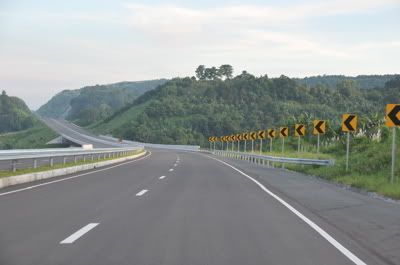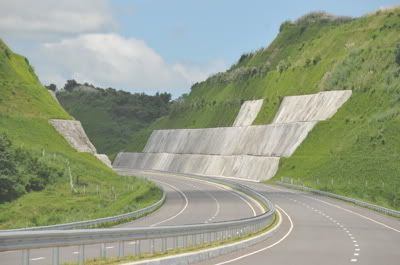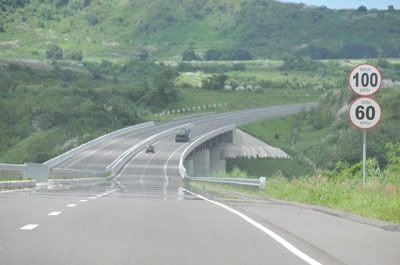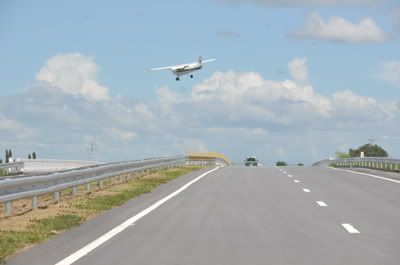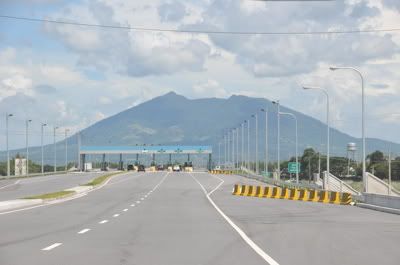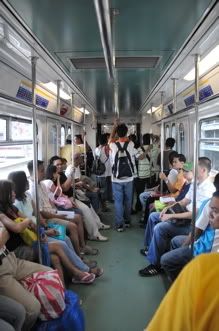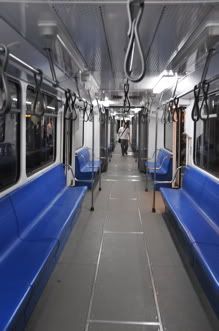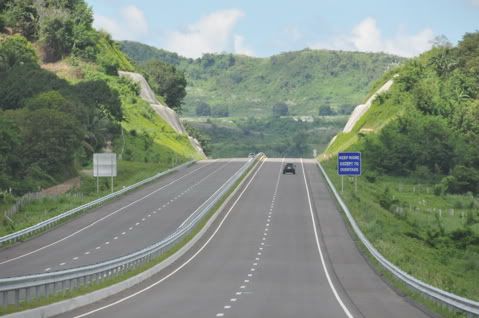
Access to Clark from the SCTEx is seen to improve with the planned opening of the Panday Pira road next week. The full report is available here. More interchanges are scheduled to open in the first quarter of 2009.

$280M more sought for Phase 1 of Northrail due to design change
The North Luzon Railways Corp. (NLRC) is requesting for an additional $280 million for the Northrail Phase 1 project due to a change in its project design.
The proposal was recently submitted to the National Economic and Development Authority’s (Neda) Infrastructure Committee (InfraCom), the interagency committee in charge of advising President Arroyo on infrastructure development, including railways, highways and airports.
Neda said the revision in its project design involved changing the narrow-gauge tracks, which were initially approved by the Neda Investment Coordination Committee (ICC) to sturdier standard or double-gauge tracks.
Neda Deputy Director General Rolando Tungpalan said the NLRC cost-increase proposal will have to go through an evaluation of the InfraCom and then go through the ICC process starting with the ICC Technical Board until the proposal obtains Neda Board approval.
However, Tungpalan said, in line with the plans of the government to speed up all infrastructure projects and programs, the Neda will also hasten its evaluation and approval of the NLRC’s request for additional funding.
The additional cost will be added to the initially approved cost of $503 million.
The China Export Import Bank will finance $421 million of the total project cost, while the remaining $82 million will be shouldered by the national government.
Phase 1 Section I of the Northrail project runs from Caloocan to Malolos, Bulacan. The contractor for the project is the China National Machinery and Equipment Group.
The NLRC stated on its web site (www.northrail.com.ph) that it aims to end 2008 with a project accomplishment rate of 61.87 percent, mostly comprised of civil works.
It also aims to acquire additional right-of-way (ROW) and relocate affected utilities by December 2008. The NLRC expects to complete the civil works for the project by August 2009.
Earlier, the Neda said seven infrastructure projects have posted cost overruns of more than P2.27 billion in the first half of 2008.
These projects include the Metro Iligan Regional Infrastructure Development Project, Rural Road Network Development Project III, Central Mindanao Road Project, Urgent Bridge Construction Project for Rural Development, and Iloilo Flood Control II.
Further, the Philippine National Railways (PNR) and Light Rail Transit Authority (LRTA) submitted cost overrun reports that showed that the Northrail-Southrail Linkage Project Phase I or the commuter- train part of the entire Northrail project will post a cost overrun of P648.12 million and the LRT Line I Capacity Expansion Project Phase II will post a P1.622-billion-worth cost increase.
The reasons include increase in prices of labor, materials and equipment/price adjustment/price escalation, changes in scope or variation orders/supplemental agreements, high bids, value-added tax and other taxes, foreign-exchange movement, increase in consulting-service costs, administrative costs, and increase in ROW or land acquisition and resettlement costs as well as price adjustments.
The 32-kilometer Northrail-Southrail linkage Phase 1 will run from Caloocan to Alabang and service 16 stations along the route. The PNR estimated that the average travel time from end-to-end is 30 to 35 minutes, while 21 new diesel railcars are expected to accommodate 187,000 passengers daily.
Phase 1 will cost $50.42 million, and around 70 percent, or $35 million, will be funded through a concessional loan from the Economic Development Cooperation Fund of Korea.
The balance will be in the form of export credit from the Korean Export-Import Bank.
The LRTA said, on the other hand, that the LRT Line I capacity expansion project Phase II will aim to extend its services to an additional 40,000 passengers per hour per direction (pphpd) from the already expanded capacity (Phase I) of 27,000 pphpd.
The agency said the project is intended to cope with the present and expected increase in volume of passengers using LRT Line 1 and the additional passenger demand to be generated under an integrated MRT Line 1, 2 and 3 system.
The project costs P11 billion, and is 85-percent financed by the Japan Bank of International Cooperation.
Below is the editorial of today's issue of the Business Mirror, which also reflects the opinion expressed yesterday in the blog.
The MRT Conundrum
MANDALUYONG Mayor Benjamin Abalos Jr. may have scored political points with
his 300,000 constituents when he decided to take on the Metro Rail Transit Corp.
(MRTC). And, he has a valid point in criticizing the national government for
undertaking, in the agreement covering the MRT, to pay the local taxes for a
private consortium, only to say later that it has no intention of doing so.
However, the millions of other residents of the capital region—of which
Mandaluyong is but a tiny slice—are not amused by his move.MRTC operates the Metro Rail Transit System, popularly known as the MRT,
Metrostar Express or Metrostar, which has a single line, MRT-3 or the Blue Line.
MRTC is a private company operating in partnership with the Department of
Transportation and Communications under a build-lease-transfer (BLT)
agreement.A judge—from Mandaluyong, naturally—has been persuaded by the mayor’s
argument that MRTC owes his city some P2 billion in real-estate taxes. The levy
pertains to three MRT-3 stations located near the intersections of Ortigas, Shaw
and Boni avenues.The local authorities of two other cities have sought to dun MRTC for
building train stops in their jurisdictions. The bid of Quezon City to exact
toll on the commuter-train operator has been dismissed, while that of Makati is
still pending. It is only in Mandaluyong—so far—that the attempt by local
officials to get their piece of the pie from a key national infrastructure has
met judicial success.With MRT-3 passenger volume topping 500,000 on weekdays, Abalos might have
been led to believe that the commuter line’s operators must be raking in
megaprofits. In fact, thanks to complications in the company’s BLT arrangement
with the national government, MRTC is not even able to generate enough revenue
to expand its fleet of coaches. Despite the spike in ridership as a result of
skyrocketing fuel prices in the past few months, the commuter-train line only
manages to continue running because of state-guaranteed earnings.When first conceived in the early 1990s, the MRT-3 was envisioned to
decongest the perennially heavy traffic on Metro Manila’s main artery, Epifanio
de los Santos Avenue (Edsa). Although Edsa still looks like a long, winding
parking lot far too often, the train has become a welcome alternative to
hundreds of thousands of commuters who need to get from the northeastern part of
Metro Manila to points further south and west of the capital region and vice
versa in a hurry. The MRT-3 passes through not just Mandaluyong, but also Pasay,
Makati, San Juan and Quezon City.Like its predecessor, the Light Rail Transit 1 that runs from Baclaran to
Monumento, and the newer line stretching from Marikina to C. M. Recto Avenue in
Manila, the MRT-3 is a key component of a grand mass-transport system that Metro
Manilans have been demanding for decades. Work has begun on yet another line
that would connect San Jose del Monte in Bulacan to North Avenue in Quezon City.It’s hard to imagine the chaos that would ensue if the legal theory that
underpinned the Mandaluyong judge’s decision affirming Mandaluyong City’s power
not only to impose real-estate taxes on the MRT-3, but also to seize the three
stations located in the city were applied to the other commuter-train lines, as
well as to civil works like the North and South Luzon Expressways, Skyway and
the Coastal Road toll way.Dozens of city, town, provincial and even barangay officials might be tempted
to exercise virtually feudal rights over national infrastructure.Local executives like Mayor Abalos ought to appreciate projects like the
MRT-3 not as another opportunity to raise funds, but as a boon to their
constituents and, just as important, an incentive to do business in their
localities.
The issues are not new. In previous years, similar mass-based transport facilities have been levied realty taxes by city governments. Parañaque City once sought to hold a public auction to sell the portions of the NAIA in its territory. Of course then Mayor Joey Marquez was shut up by the Supreme Court. Pedestrian Pinoy thinks that the city government of Mandaluyong should take a huge step back and rethink its strategy with regard to taxing the MRT-3 and taking over 3 of its stations. The concessions given to the MRTC were designed to be particularly attractive because the government could not itself undertake to build the railway, despite having the mandate to do so. And the concessions are legal (though they may not necessarily be advantageous, such as the sovereign guarantee). If private corporations involved in the construction and operation of public infrastructure were to be put at the mercy of city "kingdoms" who think themselves outside of the collective efforts at improving the economy, then the people -- who would be left expecting too much from a national government that has little will, and even less resources, to undertake big-ticket projects -- would only have their huge expectations dashed.

